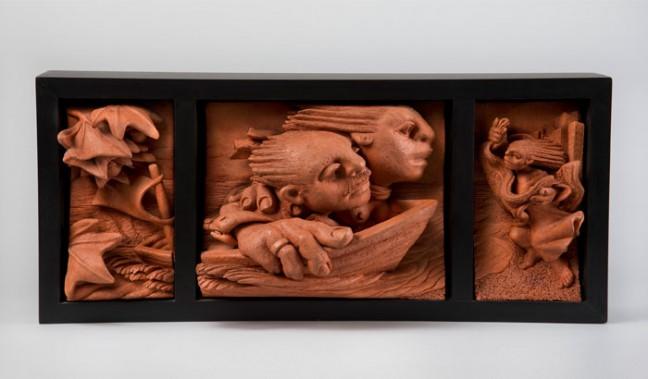If you move past the construction in front of the Chazen Museum of Art, you’ll find sculptures on the human condition in the museum’s new gallery.
“The Human Condition: The Stephen and Pamela Hootkin Collection of Contemporary Ceramic Sculpture” spans over three galleries and features 119 works from 35 different artists. This large collection contains a variety of different ceramic mediums and forms including terracotta, porcelain, vases and massive lifelike sculptures.
The most striking and widest variety of works is in the three rooms of the Pleasant T. Rowland Galleries. The first room has three enormous sculptures with different representations of people who helped introduce the extensive journey into what makes up being a human. The first, “Doggie Bob” by Robert Arneson, is a glazed ceramic sculpture of a gray shaggy dog with an old man for a head. He is sitting among his own poop, adding a tinge of dark humor.
On a more colorful note, the other two sculptures, “A Man and his World” and “Grandmother Figure,” from Viola Frey, featured two colossal lifelike human sculptures packed with a variety of colors, something not found in much of the collection.
Some of the most interesting sculptures were from Michael Lucero, in which human figures, composed of leaf-like tiles, were hanging slightly above the ground to create an eerie feeling of mystery and death. Lucero even added hair to the “Death by Cabbage,” which was a human made of cabbage leaves to make it more realistic. But the most interesting hanging sculptures depict Jesus and the Devil hanging side by side, with the Devil slightly lower to the ground, showing the human struggle of good vs. evil.
The collection does not only include enormous and lifelike sculptures, but also vases, teapots, smaller figures and figurines. A colorful vase and teapot set in the Garfield Galleries by Annie Kraus had depictions of human life that told stories through intricately painted scenes. Kraus artfully wrote quotes that capture human experience such as, “She believed a dream as countless had before.”
Another noteworthy piece was found in the Mayer Gallery titled “24 Feet” by Elise Siegel. It had a unique perspective in which 12 sculptures of little girls’ waists and legs were each placed into chairs that faced each other. Each foot is arranged to interact with the chair opposite in different ways, but none actually touch. Siegel is able to capture the innocence and playfulness of childhood in this display of little girls.
The vast variety of work in this collection depicted all aspects of human life: joy and self-harm, life and death, humor and humility. The Hootkin Collection’s ability to include such an expansive plethora of works coincides with how diverse and unpredictable the human condition can be.


